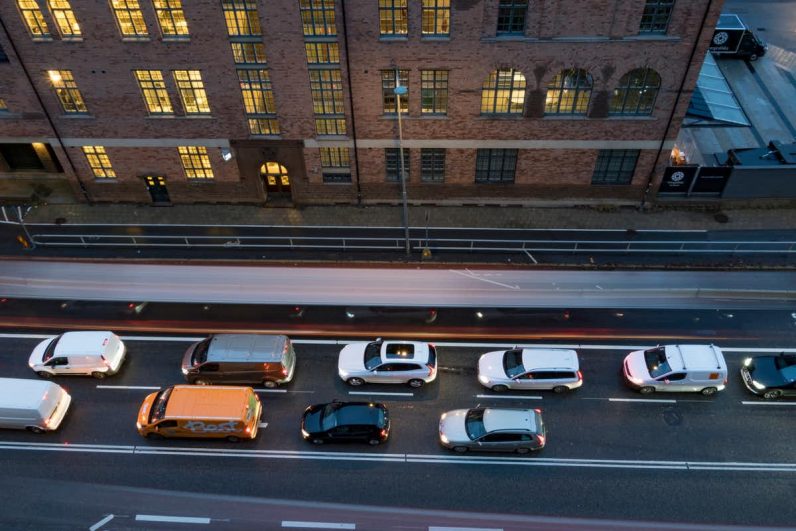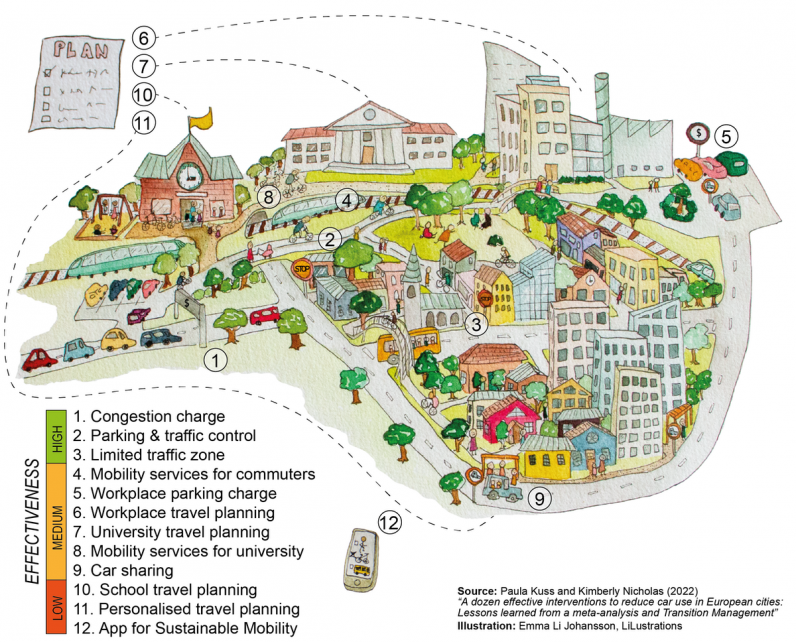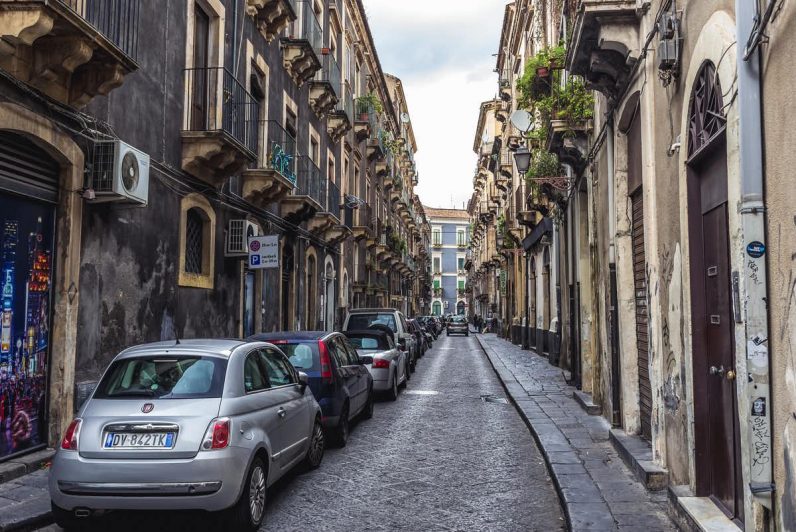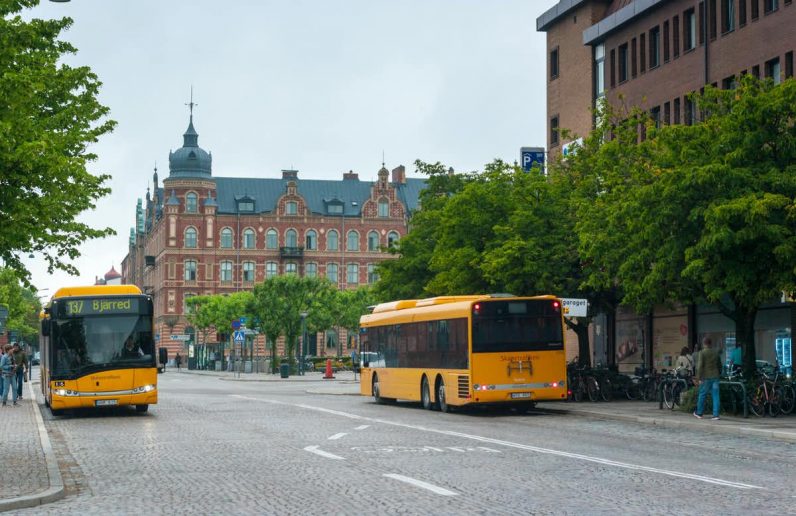[ad_1]
Question: what do the following statistics have in common?
Answer: the vehicles on our streets, primarily the not-so-humble passenger car.
Despite the (slow) migration to electric-powered cars, consumer trends are making driving even more wasteful and unequal. A recent analysis found the emissions saved from electric cars have been more than canceled out by the increase in gas-guzzling Sport Utility Vehicles (SUVs). Around the world, SUVs alone emit more carbon pollution than Canada or Germany, and are causing a bigger increase in climate pollution than heavy industry.
While cars are sometimes necessary for people’s mobility and social inclusion needs — not least those with disabilities — car-centric cities particularly disadvantage the already marginalized. In the UK, women, young and older people, those from minority communities and disabled people are concentrated in the lowest-income households, of which 40% do not have a car. In contrast, nearly 90% of the highest-income households own at least one car.
So the driving habits of a minority impose high costs on society, and this is especially true incities. Copenhagen, for example, has calculated that whereas each kilometer cycled benefits society to the tune of €0.64 (53 pence), each kilometer driven incurs a net loss of -€0.71 (-59p), when impacts on individual wellbeing (physical and mental health, accidents, traffic) and the environment (climate, air, and noise pollution) are accounted for.
So each kilometer traveled where a car is replaced by a bicycle generates €1.35 (£1.12) of social benefits — of which only a few cents would be saved by switching from a fossil-fuelled to an electric-powered car, according to this analysis.
Reducing car use in cities
Half a century ago, the Danish capital was dominated by cars. But following grassroots campaigns to change policies and streets, including replacing car parking with safe, separated bike lanes, Copenhagen has increased its biking share of all trips from 10% in 1970 to 35% today. In 2016, for the first time, more bicycles than cars made journeys around the city over the course of that year.

But while many other car-limiting initiatives have been attempted around the world, city officials, planners, and citizens still do not have a clear, evidence-based way to reduce car use in cities. Our latest research, carried out with Paula Kuss at the Lund University Centre for Sustainability Studies and published in Case Studies on Transport Policy, seeks to address this by quantifying the effectiveness of different initiatives to reduce urban car use.
Our study ranks the 12 most effective measures that European cities have introduced in recent decades, based on real-world data on innovations ranging from the “carrot” of bike and walk-to-work schemes to the “stick” of removing free parking. The ranking reflects cities’ successes not only in terms of measurable reductions in car use, but in achieving improved quality of life and sustainable mobility for their residents.
In all, we have screened nearly 800 peer-reviewed reports and case studies from throughout Europe, published since 2010, seeking those that quantified where and how cities had successfully reduced car use.
The most effective measures, according to our review, are introducing a congestion charge, which reduces urban car levels by anywhere from 12% to 33%, and creating car-free streets and separated bike lanes, which has been found to lower car use in city centers by up to 20%. Our full ranking of the top 12 car-reducing measures is summarised in this table:

The inequality of car use
Cars are inherently inefficient and inequitable in their use of land and resources. On average, they spend 96% of their time parked, taking up valuable urban space that could be put to more beneficial uses such as housing and public parks. In Berlin, car users on average take up 3.5 times more public space than non-car users, primarily through on-street parking.
And it is overwhelmingly richer people who drive the most: in Europe, the top 1% by income drive nearly four times more than the median driver, accounting for some 21% of their personal climate footprint. For these highest emitters, climate pollution from driving is second only to flying (which, on average, generates twice as many emissions).
Prioritizing cars as a means of transport also favors suburban sprawl. City suburbs typically possess larger homes that generate higher levels of consumption and energy use. North American suburban households consistently have higher carbon footprints than urban ones: one study in Toronto found suburban footprints were twice as high.
It’s also clear that road traffic levels swell to fill the size of the roads built – yet traffic planning routinely ignores the fact that this “induced demand” exaggerates the benefits and underestimates the costs of building more roads.
Electric vehicles are necessary, but they’re not a panacea. Since cars tend to be on the road for a long time, the migration to electric vehicles is very slow. Some studies anticipate relatively small emissions reductions over the coming decade as a result of electric vehicle uptake. And even if there’s nothing damaging released from an electric car’s exhaust pipe, the wear of car brakes and tires still creates toxic dust and microplastic pollution.
However a car is powered, can it ever be an efficient use of resources and space to spend up to 95% of that energy moving the weight of the vehicle itself, rather than its passengers and goods?
COVID-19: a missed opportunity?
Our study assesses urban mobility innovations and experiments introduced before the pandemic was declared. In response to COVID-19, travel habits (to begin with, at least) changed dramatically. But following large reductions in driving during the spring of 2020, road use and the associated levels of climate pollution have since rebounded to near pre-pandemic levels. Indeed, in Sweden, while public transport use declined by around 42% during the first year of the pandemic, car travel declined by only 7% in the same period, leading to an overall increase in the proportion of car use.

While entrenched habits such as car commuting are hard to shift, times of disruption can offer an effective moment to change mobility behavior – in part because people forced to try a new habit may discover it has unexpected advantages. For such behavior to stick, however, also requires changes in the physical infrastructure of cities.
Unfortunately, while European cities that added pop-up bike lanes during the pandemic increased cycling rates by a stunning 11-48%, we are now seeing a return to car-centric cities, with extra car lanes and parking spaces once again displacing cycle lanes and space for pedestrians.
Overall, the opportunities to align pandemic recovery measures with climate targets have largely been squandered. Less than 20% of government spending on pandemic measures globally were likely to also reduce greenhouse gas emissions.
The extent to which workers resume driving to their offices is another key issue determining future car use in cities. Thoughtful travel policies to reduce unnecessary travel, and opportunities for faraway participants to fully participate in meetings and conferences digitally, could slash emissions by up to 94% – and save time to boot. Those who work remotely three or more days per week travel less overall than their peers. But long car commutes can quickly wipe out such emissions savings, so living close to work is still the best option.
No silver bullet solution
The research is clear: to improve health outcomes, meet climate targets and create more liveable cities, reducing car use should be an urgent priority. Yet many governments in the US and Europe continue to heavily subsidize driving through a combination of incentives such as subsidies for fossil fuel production, tax allowances for commuting by car, and incentives for company cars that promote driving over other means of transport. Essentially, such measures pay polluters while imposing the social costs on wider society.
City leaders have a wider range of policy instruments at their disposal than some might realize – from economic instruments such as charges and subsidies to behavioral ones like providing feedback comparing individuals’ travel decisions with their peers’. Our study found that more than 75% of the urban innovations that have successfully reduced car use were led by a local city government – and in particular, those that have proved most effective, such as congestion charges, parking, and traffic controls, and limited traffic zones.
But an important insight from our study is that narrow policies don’t seem to be as effective – there is no “silver bullet” solution. The most successful cities typically combine a few different policy instruments, including both carrots that encourage more sustainable travel choices, and sticks that charge for, or restrict, driving and parking.

So here are the 12 best ways to reduce city car use:
1. Congestion charges
The most effective measure identified by our research entails drivers paying to enter the city center, with the revenues generated going towards alternative means of sustainable transport. London, an early pioneer of this strategy, has reduced city center traffic by a whopping 33% since the charge’s introduction by the city’s first elected mayor, Ken Livingstone, in February 2003. The fixed-charge fee (with exemptions for certain groups and vehicles) has been raised over time, from an initial £5 per day up to £15 since June 2020. Importantly, 80% of the revenues raised are used for public transport investments.
Other European cities have followed suit, adopting similar schemes after referenda in Milan, Stockholm , and Gothenburg – with the Swedish cities varying their pricing by day and time. But despite congestion charges clearly leading to a significant and sustained reduction of car use and traffic volume, they cannot by themselves entirely eliminate the problem of congestion, which persists while the incentives and infrastructure favoring car use remain.
2. Parking and traffic controls
In a number of European cities, regulations to remove parking spaces and alter traffic routes – in many cases, replacing the space formerly dedicated to cars with car-free streets, bike lanes , and walkways – has proved highly successful. For example, Oslo’s replacement of parking spaces with walkable car-free streets and bike lanes was found to have reduced car usage in the center of the Norwegian capital by up to 19%.
3. Limited traffic zones
Rome, traditionally one of Europe’s most congested cities, has shifted the balance towards greater use of public transport by restricting car entry to its centre at certain times of day to residents only, plus those who pay an annual fee. This policy has reduced car traffic in the Italian capital by 20% during the restricted hours, and 10% even during unrestricted hours when all cars can visit the center. The violation fines are used to finance Rome’s public transport system.
4. Mobility services for commuters
The most effective carrot-only measure identified by our review is a campaign to provide mobility services for commuters in the Dutch city of Utrecht. Local government and private companies collaborated to provide free public transport passes to employees, combined with a private shuttle bus to connect transit stops with workplaces. This program, promoted through a marketing and communication plan, was found to have achieved a 37% reduction in the share of commuters traveling into the city center by car.
5. Workplace parking charges
Another effective means of reducing the number of car commuters is to introduce workplace parking charges. For example, a large medical center in the Dutch port city of Rotterdam achieved a 20-25% reduction in employee car commutes through a scheme that charged employees to park outside their offices, while also offering them the chance to “cash out” their parking spaces and use public transport instead. This scheme was found to be around three times more effective than a more extensive program in the UK city of Nottingham, which applied a workplace parking charge to all major city employers possessing more than ten parking spaces. The revenue raised went towards supporting the Midlands city’s public transport network, including expansion of a tram line.

6. Workplace travel planning
Programs providing company-wide travel strategies and advice to encourage employees to end their car commutes have been widely used in cities across Europe. A major study, published in 2010, assessing 20 cities across the UK found an average of 18% of commuters switched from car to another mode after a full range of measures were combined – including company shuttle buses, discounts for public transport , and improved bike infrastructure – as well as reduced parking provision.
In a different program, Norwich achieved near-identical rates by adopting a comprehensive plan but without the discounts for public transport. These carrot-and-stick efforts appear to have been more effective than Brighton & Hove’s carrot-only approach of providing plans and infrastructure such as workplace bicycle storage, which saw a 3% shift away from car use.
7. University travel planning
Similarly, university travel programs often combine the carrot of promotion of public transport and active travel with the stick of parking management on campus. The most successful example highlighted in our review was achieved by the University of Bristol, which reduced car use among its staff by 27% while providing them with improved bike infrastructure and public transport discounts.
A more ambitious program in the Spanish city of San Sebastián targeted both staff and students at Universidad del País Vasco. Although it achieved a more modest reduction rate of 7.2%, the absolute reduction in car use was still substantial from the entire population of university commuters.
8. Mobility services for universities
The Sicilian city of Catania used a carrot-only approach for its students. By offering them a free public transport pass and providing shuttle connections to campus, the city was found to have achieved a 24% decrease in the share of students commuting by car.

9. Car sharing
Perhaps surprisingly, car sharing turns out to be a somewhat divisive measure for reducing car use in cities, according to our analysis. Such schemes, where members can easily rent a nearby vehicle for a few hours, have showed promising results in Bremen, Germany , and Genoa, Italy, with each shared car replacing between 12 and 15 private vehicles, on average. Their approach included increasing the number of shared cars and stations, and integrating them with residential areas, public transport , and bike infrastructure.
Both schemes also provided car sharing for employees and ran awareness-raising campaigns. But other studies point to a risk that car sharing may, in fact, induce previously car-free residents to increase their car use. We, therefore, recommend more research into how to design car sharing programs that truly reduce overall car use.
10. School travel planning
Two English cities, Brighton & Hove and Norwich, have used (and assessed) the carrot-only measure of school travel planning: providing trip advice, planning and even events for students and parents to encourage them to walk, bike, or carpool to school, along with providing improved bike infrastructure in their cities. Norwich found it was able to reduce the share of car use for school trips by 10.9%, using this approach, while Brighton’s analysis found the impact was about half that much.
11. Personalised travel plans
Many cities have experimented with personal travel analysis and plans for individual residents, including Marseille in France, Munich in Germany, Maastricht in the Netherlands and San Sebastián in Spain. These programs – providing journey advice and planning for city residents to walk, bike or use (sometimes discounted) public transport – are found to have achieved modest-sounding reductions of 6-12%.
However, since they encompass all residents of a city, as opposed to smaller populations of, say, commuters to school or the workplace, these approaches can still play a valuable role in reducing car use overall. (San Sebastián introduced both university and personalized travel planning in parallel, which is likely to have reduced car use further than either in isolation.)
12. Apps for sustainable mobility
Mobile phone technology has a growing role in strategies to reduce car use. The Italian city of Bologna, for example, developed an app for people and teams of employees from participating companies to track their mobility. Participants competed to gain points for walking, biking and using public transport, with local businesses offering these app users rewards for achieving points goals.
There is great interest in such gamification of sustainable mobility – and at first glance, the data from the Bologna app looks striking. An impressive 73% of users reported using their car “less”.
But unlike other studies which measure the number or distance of car trips, it is not possible to calculate the reduction of distance traveled or emissions from this data, so the overall effectiveness is unclear. For example, skipping one short car trip and skipping a year of long driving commutes both count as driving “less”.
While mobility data from apps can offer valuable tools for improved transport planning and services, good design is needed to ensure that “smart” solutions actually decrease emissions and promote sustainable transport, because the current evidence is mixed. For instance, a 2021 study found that after a ride-hailing service such as Uber or Lyft enters an urban market, vehicle ownership increases – particularly in already car-dependent cities – and public transport use declines in high-income areas.
Cities need to re-imagine themselves
Reducing car dependency is not just a nice idea. It is essential for the survival of people and places around the world, which the recent IPCC report on climate impacts makes clear hinges on how close to 1.5°C the world can limit global warming. Avoiding irreversible harm and meeting their Paris Agreement obligations requires industrialized nations such as the UK and Sweden to reduce their emissions by 10-12% per year – about 1% every month.
Yet until the pandemic struck, transport emissions in Europe were steadily increasing. Indeed, current policies are predicted to deliver transport emissions in 2040 that are almost unchanged from 50 years earlier.

To meet the planet’s health and climate goals, city governments need to make the necessary transitions for sustainable mobility by, first, avoiding the need for mobility (see Paris’s 15-minute city); second, shifting remaining mobility needs from cars to active and public transport wherever possible; and finally, improving the cars that remain to be zero-emission.
This transition must be fast and fair: city leaders and civil society need to engage citizens to build political legitimacy and momentum for these changes. Without widespread public buy-in to reduce cars, the EU’s commitment to deliver 100 climate-neutral cities in Europe by 2030 looks a remote prospect.
Radically reducing cars will make cities better places to live – and it can be done. A 2020 study demonstrated that we can provide decent living standards for the planet’s projected 10 billion people using 60% less energy than today. But to do so, wealthy countries need to build three times as much public transport infrastructure as they currently possess, and each person should limit their annual travel to between 5,000 kilometers (in dense cities) and 15,000 kilometers (in more remote areas).
The positive impact from reducing cars in cities will be felt by all who live and work in them, in the form of more convivial spaces. As a journalist visiting the newly car-free Belgian city of Ghent put it in 2020:
The air tastes better … People turn their streets into sitting rooms and extra gardens.
Cities need to re-imagine themselves by remaking what is possible to match what is necessary. At the heart of this, guided by better evidence of what works, they must do more to break free from cars.
Kimberly Nicholas, Associate Professor of Sustainability Science, Lund University, republished from The Conversation under a Creative Commons license. Read the original article.
[ad_2]
Source link

